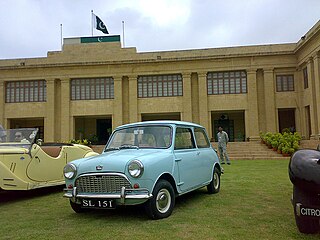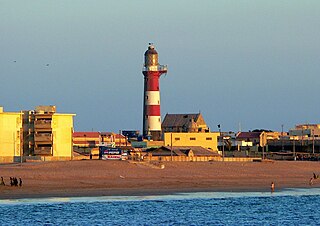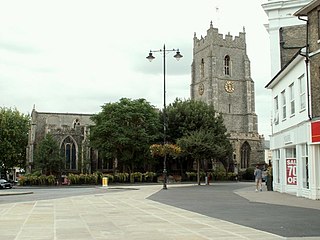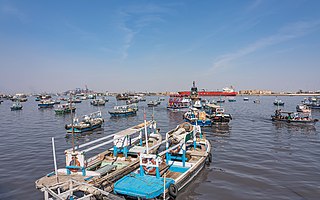
General Sir Charles James Napier, was an officer and veteran of the British Army's Peninsular and 1812 campaigns, and later a Major General of the Bombay Army, during which period he led the British military conquest of Sindh, before serving as the Governor of Sindh, and Commander-in-Chief in India.

St Giles' Cathedral, or the High Kirk of Edinburgh, is a parish church of the Church of Scotland in the Old Town of Edinburgh. The current building was begun in the 14th century and extended until the early 16th century; significant alterations were undertaken in the 19th and 20th centuries, including the addition of the Thistle Chapel. St Giles' is closely associated with many events and figures in Scottish history, including John Knox, who served as the church's minister after the Scottish Reformation.

Keamari is a neighbourhood in Karachi, Sindh, Pakistan. Keamari was originally an independent settlement that was built on a sandy ridge on the eastern side of Karachi Harbour.

The Port of Karachi is one of South Asia's largest and busiest deep-water seaports, handling about 60% of the nation's cargo located in Karachi, Pakistan. It is located on the Karachi Harbour, between Kiamari azra langri, Manora, and Kakapir, and close to Karachi's main business district and several industrial areas. The geographic position of the port places it in close proximity to major shipping routes such as the Strait of Hormuz. The administration of the port is carried out by the Karachi Port Trust, which was established in 1857.

Khaliq Dina Hall, also spelled Khaliq Deena Hall, is a library and hall located in Karachi, Pakistan. The building was built in 1906, and was after Ghulam Hoosain Khalikdina - a wealthy merchant and philanthropist who was the main financier for the building, and who wished for Karachi's Muslims to have a space for literary pursuits. It currently has a hall which is used for various events, a library, and a room that serves as the office of a local NGO.

Merewether Clock Tower or Merewether Tower is a neo-Gothic clocktower built during the Victorian era in Karachi, Pakistan. The tower is a landmark in central Karachi, and is at the termini of two of the most important roads in central Karachi: Muhammad Ali Jinnah Road and I. I. Chundrigar Road. The tower used to mark the boundary of the city when arriving from the port at Kiamari, and marked the dividing line between Karachi's Old Town and its newer European quarters to the east. It currently is the westernmost point of the Serai Quarter.

The area of Karachi in Sindh, Pakistan has a natural harbor and has been used as fishing port by local fisherman belonging to Sindhi tribes since prehistory. Archaeological excavations have uncovered a period going back to Indus valley civilisation which shows the importance of the port since the Bronze Age. The port city of Banbhore was established before the Christian era which served as an important trade hub in the region, the port was recorded by various names by the Greeks such as Krokola, Morontobara port, and Barbarikon, a sea port of the Indo-Greek Bactrian kingdom and Ramya according to some Greek texts. The Arabs knew it as the port of Debal, from where Muhammad bin Qasim led his conquering force into Sindh in AD 712. Lahari Bandar or Lari Bandar succeeded Debal as a major port of the Indus; it was located close to Banbhore, in modern Karachi. The first modern port city near Manora Island was established during British colonial Raj in the late 19th century.

St Peter's Church is the parish church of Prestbury, Cheshire, England. It is probably the fourth church on the site. The third, the Norman Chapel, stands in the churchyard. The church is recorded in the National Heritage List for England as a designated Grade I listed building. The Norman Chapel, the lychgate and west wall, the Hearse House, and the sundial in the churchyard are listed at Grade II. It is a Church of England parish church in the diocese of Chester, the archdeaconry of Macclesfield, and the deanery of Macclesfield.

St Saviour's is an Anglo-Catholic church in Pimlico, City of Westminster, London, England, located at the north end of St George's Square. It was constructed in the 1860s as part of Thomas Cubitt's development of the area on behalf of the Marquess of Westminster. The church was designed by Thomas Cundy, who had previously built St Gabriel's Pimlico a short distance away. As with St Gabriel's, St Saviour's was designed in the Gothic style and built in ragstone to emphasise the contrast with the classical stucco of its secular neighbours. The church is Grade II listed.

The Governor's House in Karachi, Sindh, Pakistan is the official residence of the governor of Sindh. The current governor of Sindh is Kamran Tessori. It is located along the Aiwan-e-Sadar Road of Karachi.

Manora is a small peninsula that forms a protective barrier between Karachi Harbour to the north and the Arabian Sea to the south. Manora, having a total population of 4,273 local residents, was formerly an island, but due to silting is now connected to the mainland by a 12 kilometer long natural sandbridge known as Sandspit. The entrance to Karachi was once guarded against pirate raids by the Manora Fort built in the 1790s, which was later upgraded by the British, and then the Pakistan Navy.

The Manora Point Lighthouse is an active lighthouse located in Manora, Karachi, on the Arabian Sea in Pakistan, where it is fourth tallest lighthouse in the country at a height of 38 m (125 ft). The lighthouse was first established on the point in 1851, being second oldest light station in the former British Indian Empire.

The Church of St Peter and St Paul is in the market town of Ormskirk, Lancashire, England. Dating from no later than the 12th century, it is one of only three churches in England to have both a tower and spire, and the only one to have them both at the same end of the church. It is an active Anglican parish church in the Diocese of Liverpool. The church is recorded in the National Heritage List for England as a designated Grade II* listed building.

The Parish Church of St Peter, Great Berkhamsted, is a Church of England, Grade II* listed church in the town of Berkhamsted, Hertfordshire, in the United Kingdom. It stands on the main High Street of the town and is recognisable by its 85-foot (26 m) clock tower.

St Peter'sChurch, Sudbury is a former Anglican church in the town of Sudbury, Suffolk, England, which now serves as an Arts Centre. The building is recorded in the National Heritage List for England as a designated Grade I listed building, and is under the care of the Churches Conservation Trust. The building stands in the heart of the town in a dominating position on Market Hill.

St Andrew's Church, also known as Scotch Church, is a gothic-style building of a presbyterian church located in Saddar, Karachi, Pakistan. It is legally protected under the Sindh Cultural Heritage (Preservation) Act.

Karachi Harbour is a narrow bay and river estuary located west of the Indus River Delta in Karachi, Pakistan. The harbour lies between the Lyari River delta and Chinna Creek to the north, and the Arabian Sea to the south. Since 1886, sections of the harbour have been improved to form the Port of Karachi - Pakistan's busiest seaport.

Manora Fort is a fort that was built to protect the harbour of Karachi. Originally erected as a mud fortress by the Talpur Mirs in 1797, the fort was captured by the British in 1839 - after which they seized control of Karachi and lower Sindh.

The Grade I listed, mainly Norman Church of Saint John the Baptist in Adel, Leeds, West Yorkshire, England has been described by Nicholas Pevsner as 'one of the best and most complete Norman churches in Yorkshire'. It is most notable for its magnificent south doorway with surrounding carvings, and highly carved Norman chancel arch. There is also a replica of a 13th-century sanctuary ring on the exterior of the south door, the original having unfortunately been stolen in 2002. The church is an active Anglican parish church in the archdeaconry of Leeds and the Diocese of Leeds.

The Karachi Port Trust Building, also referred to as the KPT Building, is a large colonial-era building in Karachi, Pakistan that serves as headquarters for the Karachi Port Trust, which administers the Port of Karachi. The building dates from the height of the British Raj, and was inaugurated on 5 January 1916.





















